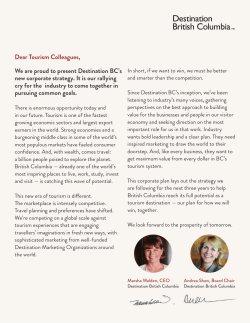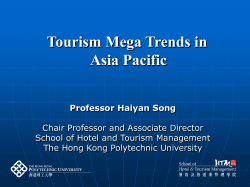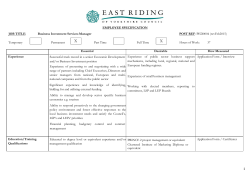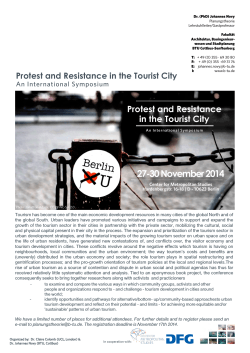
academicjournalonline.in
International Journal of Trends in Commerce & Economics Volume 1, Issue 6, 2014 © Naik & Khan An Outcome of Road Transportation and Highways in Sustained Growth of Tourism - an Overview Balachandra Naik, Research Scholar, Bharathiar University, Coimbatore Dr. R. Y. Khan, Principal, Principal Investigator & Research Guide, Govt. First Grade College, Sirsi ABSTRACT The study provided a brief discussion on Road Transportation and Tourism Development. This Paper examines the relationship between transportation and development of tourism. The attempt is made to qualitatively test of the relationship between presence of transportation measured by road connectivity and road condition and tourism development measured by location national parks. The major findings of the study is that road transportation is a significant determinant of tourism development. The study focused the potentialities of Road transportation for tourism development. The study also discussed the benefits of tourism in India, tourism resources, short coming & necessary actions for developing tourism, tourists arrivals etc. The study highlighted the development of Indian tourism in relation with road transportation development. Key words: Road Transport, Highways, Tourism, Development, Travel. INTRODUCTION Transportation is an essential part of the tourism industry and it plays an important role as well. Traveling would be impossible without road transportation. Expansion of tourism is the outcome of improvement of transportation. Tourism has been trying to meet the demands of the tourists and that means improving the transportation facilities and building better transport system including high quality highways. Transportation and the advanced vehicles have made travel to all the concerns of India. It had brought tourism to a whole new level. The State with an efficient road transport is opening up tour packages. GENERAL BACKGROUND Tourism is all about travel and the role of transportation in its operation is visited. It is largely due to the improvement of road transportation that tourism has expanded. The road transportation has made travel to anywhere possible. India’s road network of 3.34 million km International Journal of Trends in Commerce & Economics Volume 1, Issue 6, 2014 © Naik & Khan is the second-largest in the world. Out of this, national highways account for 65,569 km, state highways for 130,000 km, and major district roads, rural and urban roads collectively account for 3.14 million km, as per statistics with the Ministry of Road Transport and Highways. According to the ministry, roads remain the most important means of transport, accounting for 85% and 65% of passenger and freight traffic, respectively, in India. Broadly, the road network in India is divided into the primary system comprising national highways and the secondary system made up of state highways and major district roads. In addition, the network comprises expressways as well as rural and other roads. National highways account for a mere 2% of the total road length, but carry 40% of the total road traffic. Economical for short distance -road transport is economical for short distance. Again, the loading and unloading charges are reduced due to direct transportation. Where the distance is short, road transport is not only economical, but also quicker .Low investment - road transport requires low investment. The vehicles such as trucks and tempos cost comparatively less as compare to trains, ships and aero planes.National highways account for a mere 2% of the total road length, but carry 40% of the total road traffic. Between 2006 and 2009, the national highway network increased by 4,000 km and the state highway network increased by 170,000 km. Of the total length of the national highway network, about 27% is single-laned or intermediate-laned, 54% is two-laned and 19% is four-laned. The Ministry of Road Transport and Highways is planning to seek credit worth USD 2.96 billion from the World Bank for the conversion of single-laned, intermediate-laned and two-laned roads covering a total length of about 3,770 km. The project is scheduled for completion in 2014. The state highways and major district roads carry 40% of total road traffic and constitute 13% of India’s total road length. The 11th Five-Year Plan (2007–2012) has projected an investment requirement of USD 8,613.95 million for the development of rural roads under the Pradhan Mantri Gram Sadak Yojana. The government provides various incentives for private and foreign sector investment in the roads sector. 100% foreign direct investment (FDI) under the automatic route is allowed for support services to land transport such as operation of highway bridges, toll roads, and vehicular tunnels; services incidental to transport such as cargo handling is incidental to land transport; construction and maintenance of roads, bridges; and construction and maintenance ©IJTICE 9 International Journal of Trends in Commerce & Economics Volume 1, Issue 6, 2014 © Naik & Khan of roads and highways offered on build-operate-transfer (BOT) basis, including collection of toll. Highway-widening projects qualify for the 10-year tax break under Section 80 IA of the Income Tax (IT) Act. Other policy initiatives for attracting private investment are government to provide capital grant up to 40% of project cost to enhance viability on a case-to-case basis, 100% tax exemption for five years and 30% relief for next five years, which may be availed of in 20 years and concession period allowed up to 30 years. FDI in construction activities (including roads and highways) sector from April 2000 to July 2011 in India was USD 9.3 billion. This amounted to 6.4% of the total FDI inflows, according to data released by Department of Industrial Policy and Promotion (DIPP), which formulates the FDI policy and is part of the Ministry of Commerce & Industry. In addition to the policy benefits, the government has announced several incentives to attract private sector participation. These include government to bear the cost of the project feasibility study, land for the right of way and way side amenities, shifting of utilities, environment clearance, cutting of trees, etc; duty free import of high capacity and modern road construction equipments; declaration of the road sector as an industry; easier external commercial borrowing norms; right to retain toll; increase in the overseas borrowing amount of infrastructure sectors to USD 500 million from USD 100 million; and full exemption from basic customs duty to bio-asphalt and specified machinery for application in the construction of national highways. The ministry has also framed a ‘Special Accelerated Road Development Programme in North Eastern Region’ for improving road connectivity to remote places in this region. The estimated cost of the proposal is USD 2.53 billion. The Union Budget 2012–13 proposed an increase of allocation of the Ministry of Road Transport and Highways by 14% to Rs. 25,360 crore. Further, the World Bank has approved a USD 975 million loan for developing the first phase of the eastern arm of the USD 17.21 billion Dedicated Freight Corridor Project in India. The Dedicated Freight Corridor Corporation of India Ltd. has tied up with the Japanese Bank of Industrial Cooperation for USD 14.56 billion funding as loan for the first phase and it is likely to be commissioned in 2016. 10 © IJTICE International Journal of Trends in Commerce & Economics Volume 1, Issue 6, 2014 © Naik & Khan The World Bank and the Government of India have also signed a USD 350 million loan to accelerate the development of road network through the Second Karnataka State Highway Improvement Project. The Government of Karnataka has demarcated about 25,000 km of the most important traffic corridors and designated them as the state’s core road network. Also, a USD 301.38 million-worth project, ending 2016, for construction, up gradation and improvement of 433 km-long road in six north-east states, assisted by the Asian Development Bank, has been approved by the Cabinet Committee on Economic Affairs. The Ministry of Road Transport and Highways had planned to award road projects covering 10,000 km of highways in 2011–12. About 80% of these road projects will be distributed on the BOT basis. The Prime Minister Gram Sadak Yojana (PMGSY) is a scheme for development of rural roads in India. The Construction of Rural Roads Project (CRRP) is another initiative focused on rural development.India located in the southern part of Asian Continent is one of the most charming countries of the world. There is long list of diversified tourist attractions in India. India is counted best tourist places in world. There are lot of tourist places where any tourists enjoy and passes there time. OBJECTIVE OF THE STUDY 1. To evaluate the role of road transportation in the development of Tourism. 2. To help people become aware of the value of the states biodiversity through education, the dissemination of information and awareness building. 3. To develop new approaches in tourism to educate the tourists & the public. 4. To know major impacts on the economic and the environment, caused by transportation. 5. To build better road transport system including high quality highways which will ease the tourism industry improve. ©IJTICE 11 International Journal of Trends in Commerce & Economics Volume 1, Issue 6, 2014 © Naik & Khan LITERATURE REVIEW • Wood and Johnson elucidate that transport is a public utility which is vital to the overall public interest. Almost every business enterprise and every individual is directly affected by the transportation industry. • Kitchin analyzed operational activities of bus transport irrespective of the size of the organization engaged in bus transport and observed that it should have three main sections viz., traffic, secretarial and engineering and each having clearly defined function • M.O. Mathew emphasized the efficiency of the transport industry as a whole and the public utility industry in particular. He opined that transport being regulated by the Governmental policies in many ways, of which some have a direct impact on the evolution of size. • Bonavia M.R highlighted the role and significance of transport system for the development of a country and suggested the utility of good transport system for industrial, political, social and cultural angles. • According to Laws et al. (2002) destination tourism management has during past years developed from early ad hoc, opportunistic and entrepreneurial responses into a more proactive decision-making. RESEARCH METHODOLOGY The present study is based on both primary and secondary data. Information & data have been collected from published & unpublished sources. The primary data is collected by survey in Goa, Karnatak and Uttara Kannada District. The collected data is analyzed clearly to understand that the road & highways development leads to tourism. BENEFITS OF TOURISM CAUSED BY ROAD TRANSPORTATION DEVELOPMENT 1) Tourism minimizes the negative impacts on the local people and the natural environment. 2) Tourism directs economic and other benefits to the local people by providing them employment. 12 © IJTICE International Journal of Trends in Commerce & Economics Volume 1, Issue 6, 2014 © Naik & Khan 3) It promotes conservation of natural assets and enhances the cultural integrity of the local people. 4) Tourism has become the major source of income and is attracting lot of travel agencies than ever before. 5) It promotes the preservation of wildlife and the natural habits. 6) Providing positive attitude and experience among the travelers. 7) Tourism supports the international labour agreements. FOREIGN TOURISTS ARRIVALS - GROWTH RATES THROUGH ROAD & HIGHWAYS DEVELOPMENT India has one of the largest and fastest growing tourism sectors. Development of road transport and highways brings about improving steps in tourism industry. Travel accommodation witnessed the entry of many foreign players who foresaw huge demand for budget hotels and subsequently planned to launch their branch in India. A few leading foreign chains and domestic players including Starwood capital and Carlson Hotels are adding capacity to increase supply in the budget segment. Foreign Tourist Arrivals (FTAs) during December 2012 and comparative figures of 2011 and 2010 Month Foreign Tourist Arrivals (FTAs) Percentage Change 2010 2011 2012 2011/10 2012/11 (%) January 5,68,719 6,22,713 6,81,002 9.5 9.4 February 5,52,152 6,27,719 6,81,193 13.7 8.5 March 5,12,152 5,35,613 6,06,456 4.6 13.2 April 3,71,956 4,46,511 4,47,581 20 0.2 May 3,32,087 3,83,439 3,74,476 15.5 -2.3 June 3,84,642 4,05,464 4,33,390 5.4 6.9 July 4,66,715 4,75,544 4,85,808 1.9 2.2 August 4,22,173 4,28,490 4,45,632 1.5 4.0 September 3,69,821 4,17,478 4,11,562 12.9 -1.4 October 5,07,093 5,59,641 5,56,488 10.4 -0.6 ©IJTICE 13 International Journal of Trends in Commerce & Economics Volume 1, Issue 6, 2014 © Naik & Khan November 6,08,178 6,69,767 7,01,185 10.1 4.7 December 6,80,004 7,36,843 7,52,972 8.4 2.2 57,75,692 63,09,222 65,77,745 9.2 4.3 Total Source: Bureau of Immigration and Ministry of Tourism. A BRIEF PROFILE OF UTTAR KANNADA AND GOA A good highway link between Karnataka and Goa encouraged the tourism development. Uttar Kannada district includes 11 talukas on the basis of its fine different geographical and climate conditions. The district is broadly classified under three regions as the coastal region, hill region and the semi arid region. Out of total population 62.78% inhabited in rural and 37.22 population in urban areas. The district also popularly know by its nickname as The Kashmir of Karnataka GOA THE HOLIDAY DESTINATION Goa is the most popular holiday destination in India. A wonder full blend of Indians and foreigner and equally wonderful marketplaces make it the perfect vacation spot. It has a small area of mere 3702sq/km. In title Goa (GA) state comprises two districts. The ISOCODE assigned by International Organization is GA Comparative Brief Profile of Goa and U.K District FCTORS AREA GOA UK District Area Sq/Km 3702 10291 Population (2011) 14.59 lakhs 14.39 Density of Population 394 140 Forest Coverage Sq/Km 1424 (38.47) 8144 (79.14) NH-224 kms NH-334 kms SH-232 kms SH-665 kms DR-815 kms DR-1214 kms Roads Source: 1 www.google search Goa. 2. Statistical Hand Book of Uttara Kannada Dist. It can be found from the above table no.1 is that UK District has a geographical area of about 10291 sq/km whereas the area of Goa has only 3702sq/km. The forest coverage area of the 14 © IJTICE International Journal of Trends in Commerce & Economics Volume 1, Issue 6, 2014 © Naik & Khan Uttara Kannada district is 8144 sq/km. In almost all other factors like roads railways, aviation, per capita income and literacy rate of Goa has comparative advantage over Uttar Kannada district. FOREIGN TOURISTS ARRIVALS Tourism is characterized by following concerns. It is multidisciplinary with the human dimension of tourism attracting the attentions of geographers, historians, behavioral scientists, travelers, roads, highways etc. while the nature of tourism as commercial activity appeals to those engaged in economics and business activities. FOREIGN TOURISTS ARRIVALS YEAR FOREIGN TOURISTS GROWTH RATE (In ARRIVALS (In millions) %) 2001 2.54 - 2002 2.38 93.70 2003 2.73 114.70 2004 3.46 126.73 2005 3.92 113.30 2006 4.45 113.52 2007 5.08 114.16 2008 5.28 103.94 2009 5.17 97.92 2010 5.78 111.79 2011 6.31 109.17 2012 6.58 104.27 2013 3.21 - Source: Tourists Statistics, 2012, Ministry of Tourism ©IJTICE 15 International Journal of Trends in Commerce & Economics Volume 1, Issue 6, 2014 © Naik & Khan 140 120 100 80 Growth rate 60 40 20 0 2001 2003 2005 2007 2009 2011 2013 CONTENT WISE ARRIVALS India is one of the important tourism destinations in Asia Pacific region. The scenic beauty, wildlife, religious places, historic and centrally protected monuments, the rich culture etc. are the attractions of our country, which satisfy tourists through well developed roads. The following table presents the continent wise arrivals to India. CONTENT WISE ARRIVALS Mean CONTINENT 2009 2010 2011 2012 CAGR Score RANK (%) Asia 18.90 21.35 24.17 25.40 134.39 22.45 I Europe 18.17 19.78 21.14 21.67 119.26 20.19 II North and 10.99 12.37 13.01 13.60 123.75 12.50 III 1.83 2.11 2.33 2.45 133.88 2.18 IV South America Australia 16 © IJTICE International Journal of Trends in Commerce & Economics Volume 1, Issue 6, 2014 Africa 1.65 2.05 2.33 2.62 © Naik & Khan 158.19 2.16 V 160 140 120 100 80 CAGR MeanScore Rank 60 40 20 0 Asia Africa North & South America TOURISTS INFLOW IN KARNATAKA Karnataka attracted around 84.86 million tourists with around 84.10 million domestic tourists and 0.57 million international tourists in 2011. The tourists figures for the last five years along with associated growth rates are provided in the following table. Domestic and International visitors to Karnataka Domestic 2005 2006 2007 2008 2009 2010 2011 24,698,2 36,195,9 37,825,9 37,010,9 32,729,6 38,202,0 84,107,3 43 07 53 28 79 77 90 47% 5% -2% -12% 17% 120% 5,05,524 5,34,563 5,20,041 2,29,847 3,24,573 5,74,005 -7% 6% -3% -56% 41% 77% 25,243,4 36,701,4 38,360,5 37,530,9 32,959,5 38,526,6 84,681,3 68 31 16 69 26 50 95 Growth Rate Internation 5,45,225 al Growth Rate Total ©IJTICE 17 International Journal of Trends in Commerce & Economics Volume 1, Issue 6, 2014 Growth 45% 5% -2% © Naik & Khan -12% 17% 120% Rate Source: Department of Tourism, Karnataka 120 100 80 60 40 20 0 -20 -40 -60 Domestic Rate International Rate Total Rate 2005 2007 2009 2011 Opinion of the Respondents on Comparative Factors of U.K Dist and Goa Good Satisfactory Not- Good Satisfactory Satisfactory NotSatisfactory U.K. Goa District Tourists 62.38 24.56 13.06 40.88 21.44 37.69 23.83 22.50 53.67 65.33 33.67 1.00 19.17 34.00 46.83 68.33 25.83 05.84 Spots Transport Services Roads Source: Compelled from field Survey 18 © IJTICE International Journal of Trends in Commerce & Economics Volume 1, Issue 6, 2014 © Naik & Khan UTTAR KANNADA DISTRCT 70 60 50 40 Good 30 Satisfactory 20 Not Satisfactory 10 0 Tourists Transport Spots Se rv ice s Roads GOA 70 60 50 40 Good Satisfactory Not Satisfactory 30 20 10 0 Tourists Spots Roads Tourist inflow to major tourism destination in Karnataka 2011 Destination Domestic Tourists International Total Tourists Tourists Bangalore Urban 59,59,529 Bangalore Rural 5,71,265 ©IJTICE 89,597 60,49,126 - 5,71,265 19 International Journal of Trends in Commerce & Economics Volume 1, Issue 6, 2014 © Naik & Khan Chitradurga 6,28,369 582 6,28,951 Davanagere 4,18,432 - 4,18,432 Kolar 3,29,856 - 3,29,856 Shimoga 23,01,688 5,099 23,06,787 Tumkur 43,83,594 - 43,83,594 Ramnagar 27,74,533 6,377 27,80,910 Chikkaballapur 13,32,173 - 13,32,173 Belgaum 27,59,800 - 27,59,800 Bagalkot 19,44,865 23,706 19,68,571 Bijapur 16,47,931 2,808 16,50,739 3,24,707 1,941 3,26,648 Dharwad Haveri 7,300 Gadag 2,84,919 437 2,85,356 20,05,769 36,533 20,42,302 7,50,262 - 7,50,262 Bidar 13,87,478 - 13,87,478 Bellary 25,04,034 81,900 25,85,934 Koppal 26,44,331 51,938 26,96,269 Raichur 7,900 - 7,900 Yadgiri 64,045 - 64,045 Mysore 1,32,60,373 1,14,160 1,33,74,533 Hassan 34,00,014 1,06,846 35,06,860 Mandya 70,40,670 31,283 70,71,953 Chamarajnagar 39,49,593 1,983 39,51,576 Kodagu 18,10,960 5,297 18,16,257 Dakshina Kannada 87,69,681 2,577 87,72,258 Udupi 27,51,891 10,477 27,62,368 Chikmagalur 80,91,428 464 80,91,892 Uttar Kannada Gulburga 20 - 7,300 © IJTICE International Journal of Trends in Commerce & Economics Volume 1, Issue 6, 2014 Total 8,41,07,390 © Naik & Khan 5,74,005 8,46,81,395 SUGGESSTIONS (1) Identify tourism potential While tourism is the world’s largest industries not all areas are equally suited for successful tourism development. Potential business operators or local development organization must have a clear picture of specific tourism, draws and activities examine questions such as: • What does this place offer in terms of natural areas? • Why will tourists be attached to the area? • What services or activities can a business offer that responsible explores the natural environment? • How can tourism benefit the environment and the local community? (2) Conduct Market Research Determine whatever a demand for tourism service in the local area exists or can realistically be developed. Tourism relies in large part on a population of visitors with disposable incomes. Potential businesses owners must assess the areas potential to draw tourists and decided how to meet the demand their visiting population. (3) Develop a business plan A business plan is a tool that provides communication, management and planning information to investors’ employers, local communities and business owners. A business plan for tourism should information on how the business will protect, rather than exploit, the local environment and how it will benefit the community. (4) Market tourism services Business or multi business/community partnerships need to reach out to potential customers to advertise the particular area as an eco-tourism destination and the specific services available. Target marketing efforts in outlets used by potential customers such as travel or outdoor magazines or environmental publications. (5) Grow and expand services ©IJTICE 21 International Journal of Trends in Commerce & Economics Volume 1, Issue 6, 2014 © Naik & Khan Businesses and development organization should work together to grow opportunities for tourism within an area, several niche markets for eco-tour activities and services can likely be identical and expanded to grow the regions recognition as tourism destination. (6) Make foreigners believe that India is safer, economical, transportable, and healthy should have been seen at least once in a lifetime. CONCLUSSION Tourism is a unique endeavor that altered conservation efforts in numerous ways. Tourism is an innovative approach to sustainable and profitable conservation and hopefully with further research and refinement. Tourism with road and highways development will grow in success. Building tourism business requires research planning & community partnerships Road and highway development can contribute to conserve cultural & Natural Heritages, Better cooperation between public and private sectors, sustainable use of Natural and Historic areas. Road Transportation brings about changes in tourism and leads to development of tourism with specialization. REFERENCES: 1. Dr. Santosh P. Thampi, Eco-development project. 2. Indian Roads Congress, (1994), “Guidelines for the Design of at Grade Intersections in Rural Area and Urban Areas”. IRC SP 41, New- Delhi. 3. Indian Roads Congress, (1990), “Guidelines for Capacity of Urban 6. Roads in Plain Areas”. IRC: 106, New- Delhi. 4. Department of Tourism Govt. of India 5. ECER master plan 2007 east coast economic development council.kuala Lumpur. 6. http:// www.ecerdc.com/ecccrdc/about.htm 7. Culpan R (1987) International Tourism model for developing Economics, Annuals of Tourism Research, vol, 14, 541 8. Duval D.T (2007) Tourism and Transport: mode network and Flows, channel view. 9. Bhalla K., M. Ezzati, A. Mahal, J. Salomon, and M. Reich. 2007. A risk-based method for modeling traffic fatalities. Risk Analysis 27: 125–36. 22 © IJTICE International Journal of Trends in Commerce & Economics Volume 1, Issue 6, 2014 ©IJTICE © Naik & Khan 23
© Copyright 2024









